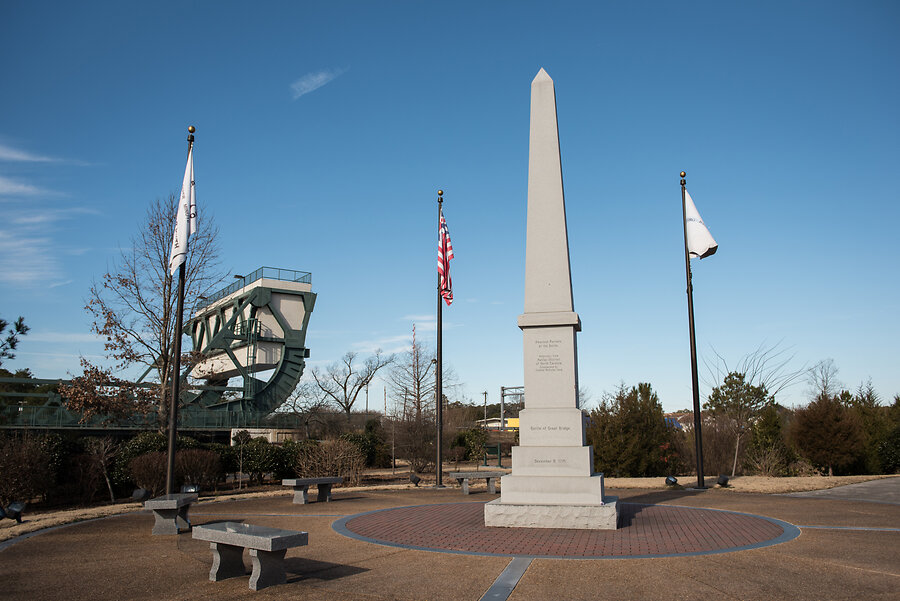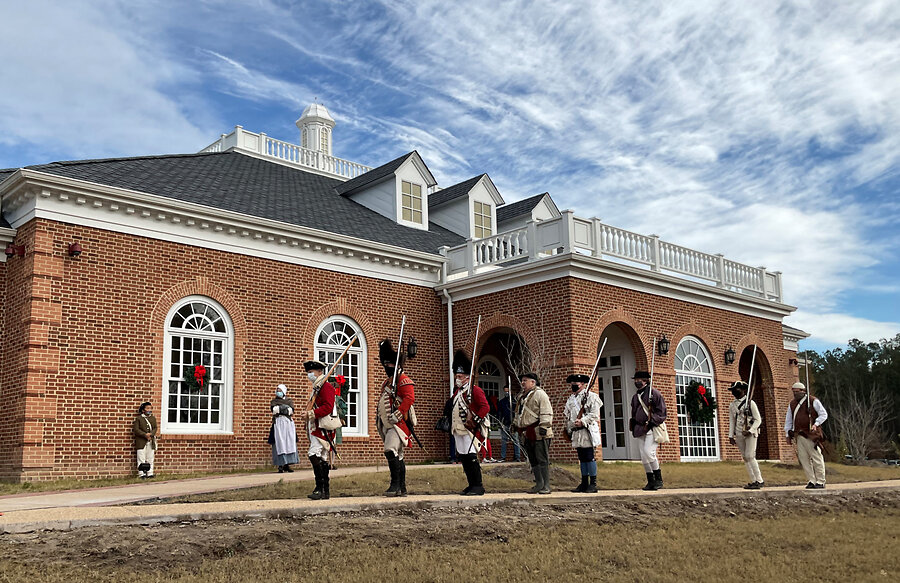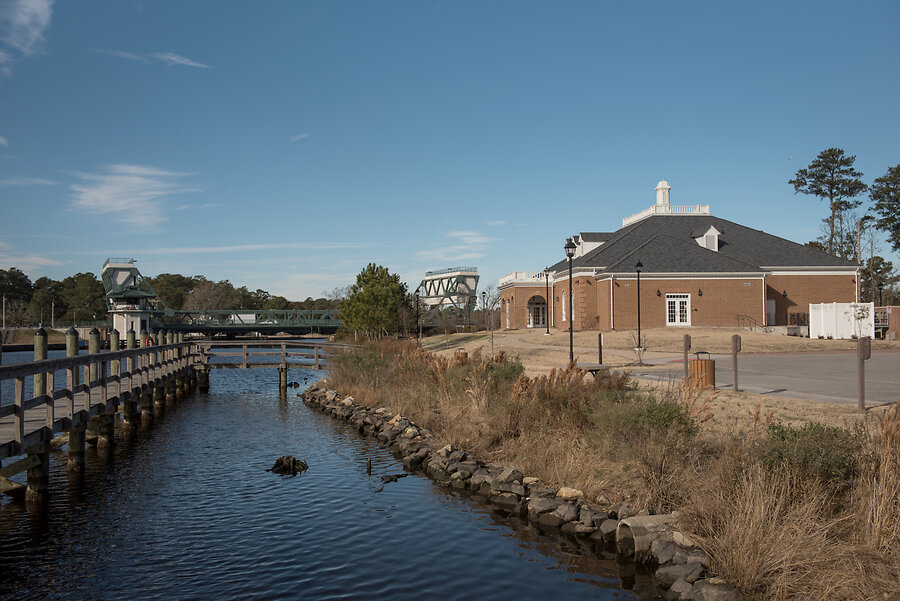 THE BATTLE OF GREAT BRIDGE Chesapeake museum commemorates a turning point in American History by Rob Lauer For many locals, the only battle they associate with Battlefield Boulevard is battling traffic during rush hour. Few realize that the road has been a busy thoroughfare for centuries-which is why, on December 9, 1775, it was the site of one of the earliest battles of the American Revolution. This is just one of the fascinating facts that one can learn by visiting The Great Bridge Battlefield and Waterways History Museum. A stunning, redbrick Colonial-style edifice that overlooks the Intracoastal Waterway, the museum is clearly visible from Battlefield Boulevard. Turning off the road just north of the bridge, guests drive past rustic split-rail fences (the type commonly erected during the Colonial era) to the museum's scenic, secluded parking lot. Inside the museum, eight galleries dedicated to the Battle of Great Bridge and local waterways' history await visitors. Here they will learn, among other things, that the road now known as Battlefield Boulevard has always seen traffic. "Two hundred and fifty years ago, this road was the only land route from North Carolina to Norfolk," Executive Director Elizabeth Goodwin explains. "In December 1775, the British military stationed in Norfolk saw the route as essential in getting needed supplies from the south. By securing the road, the Patriots hoped to cut off those supplies to the British and secure a path north to General Washington and the troops under his command. "But the Battle of Great Bridge didn't happen overnight," Elizabeth points out. "A chain of events beginning in the spring of 1775 set the stage for the conflict." In April 1775, following the Battle of Concord in Massachusetts, a nervous Lord Dunmore-the royal governor of Virginia-ordered British forces to remove the gunpowder from Williamsburg's storehouse. A confrontation between royal and colonial militia forces ensued. Although the incident ended without violence, Dunmore feared for his family's safety. Leaving Williamsburg in June 1775, he placed his family on board a Royal Navy ship, and a small British fleet docked at Norfolk. From Norfolk, Dunmore sought to protect his supply line from the south by fortifying the bridge across the Elizabeth River in the village of Great Bridge. A small stockade, Fort Murray, was built on the Norfolk side of the bridge, armed with two cannons and between 40 and 80 men.  Photo courtesy of Michele Thompson "The British didn't think there'd be any action
here at all," Historian Katherine Gruber notes. "They actually thought,
‘Those Virginians entrenched down there are cowards. They're not going
to come out. We're going to have a really quiet winter down here in
Great Bridge.' And guess what? That's not what happens at all." In
response, Virginia's assembly ordered its militia troops to march on
Norfolk. William Woodford, the colonel leading the Second Virginia
Regiment, advanced toward Great Bridge with 100 riflemen from the
Culpeper Minutemen. On December 2, they set up a camp south of the
bridge across from the British fort. More Patriots joined Woodford. By
December 9, when the British attacked, his numbers had grown to nearly
900 men. "The importance of the Battle of Great Bridge can't be overstated." - Katherine Gruber  Photo courtesy of museum "The importance of the Battle of Great Bridge can't be overstated," she says. "This is the first time that the Virginia Patriots are going to take up arms against Lord Dunmore, their last colonial governor, and they're going to expel the British from Virginia for a number of years. British forces aren't going to come back to challenge the Patriots in Virginia until about 1780. One of the reasons that Virginia goes for revolution in earnest is because of the victory here at the Battle of Great Bridge. Woodford would later write that the Battle of Great Bridge was a Bunker Hill in miniature. The Patriots win. They show their metal- their determination, and that provides an incredible morale boost to the fledgling support for liberty here in Virginia. "The Battle of Great Bridge is also very much a civil war battle," Katherine continues. "You have Virginian militia-Patriots-fighting loyalist members of the King's own regiment. You have Virginians against Virginians, fighting for different ideologies. It's also a very significant battle because you have African-Americans fighting on both sides as well. You have slaves who have run away from their rebel masters to join Dunmore's Ethiopian Regiment to fight for the British during the war. And you have free African-Americans such as Billy Flora, who becomes a hero during the Battle of Great Bridge fighting in the name of liberty and freedom here as well." The Patriots won the Battle of Great Bridge in a mere 30 minutes. As a direct result of the victory, four days later, the Virginia Convention in Williamsburg adopted its first public declaration expressing a spirit of independence.  Photo courtesy of Michele Thompson Because of the British defeat at Great Bridge, Lord Dunmore and his soldiers evacuated Virginia—but not before their ships bombarded Norfolk on January 1, 1776. In May, the Virginia Convention declared the Commonwealth’s independence from England. By June, they sent a proposal to the Continental Congress in Philadelphia stating, “these colonies are, and of right ought to be, free and independent states.” That proposal resulted in the writing and signing of the Declaration of Independence in July 1776. To commemorate and raise awareness of the battle’s important place in Revolutionary War history, The Great Bridge Battlefield & Waterways History Foundation was founded on December 9, 1999. Visitors to the museum can also enjoy Battlefield Park (part of the City of Chesapeake’s park system), as well as historic and nature trails. Many locals mistakenly assume that the Battle of Great Bridge took place on the Intracoastal Waterway. “In 1775, the waterway and draw bridge weren’t here,” Elizabeth explains. “The original bridge was a wooden structure about a block north, where Battlefield Boulevard now crosses the Southern Branch of the Elizabeth River. Because the Intracoastal Waterway now gets so much attention, most people drive over the original bridge’s site without even noticing it.” Another little-known fact about Great Bridge’s Colonial past that commuters can remember during rush hour on Battlefield Boulevard. “We’re not stuck in traffic; we’re driving through American history. Great Bridge Battlefield and Waterways History Foundation 757-482-4480 http://www.gbbattlefield.org |